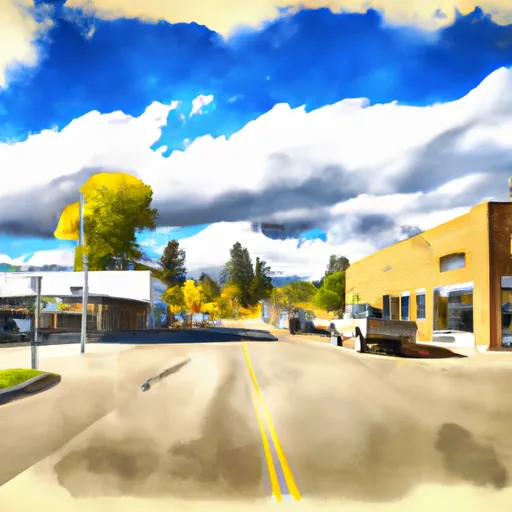-
 Snoflo Premium
Snoflo Premium
Get unlimited access to all our content
With no Ad interruptions! - Start Your Free Trial Login with existing account
Melville
Eden Index
Climate
7.0
•
Recreation
•
Community
•
Safeguard
2.8/10

Melville, Montana is a small rural town located in Sweet Grass County, in the southwestern part of the state. It is situated in the beautiful Big Timber Creek Valley, surrounded by picturesque mountains and rolling hills.
The climate in Melville is classified as a continental climate, characterized by cold, snowy winters and warm summers. Average temperatures range from around 20°F (-6°C) in January to 80°F (27°C) in July. Precipitation is relatively evenly distributed throughout the year, with slightly higher amounts in the summer months.
As for hydrology, Melville benefits from the nearby Big Timber Creek, which flows through the town. This provides opportunities for fishing, boating, and other water-based activities. The area also has several small lakes and ponds, offering additional recreational options.
Outdoor enthusiasts will find plenty of activities to enjoy in and around Melville. The surrounding mountains and valleys offer ample opportunities for hiking, camping, and wildlife viewing. The nearby Crazy Mountains provide opportunities for hunting and horseback riding, while the Gallatin National Forest, just a short drive away, offers extensive trail systems for hiking, mountain biking, and off-roading. Overall, Melville is a haven for those seeking a close connection with nature and a wide range of outdoor recreation opportunities.
What is the Eden Index?
The Snoflo Eden Index serves as a comprehensive rating system for regions, evaluating their desirability through a holistic assessment of climate health, outdoor recreation opportunities, and natural disaster risk, acknowledging the profound impact of these factors on livability and well-being.
Climate Health Indicator (CHI): 7.0
Melville receives approximately
455mm of rain per year,
with humidity levels near 69%
and air temperatures averaging around
6°C.
Melville has a plant hardyness factor of
4, meaning
plants and agriculture in this region thrive during a short period during spring and early summer. Most
plants will die off during the colder winter months.
By considering the ideal temperature range, reliable water supplies, clean air, and stable seasonal rain or snowpacks, the Climate Health Indicator (CHI) underscores the significance of a healthy climate as the foundation for quality living.
A healthy climate is paramount for ensuring a high quality of life and livability in a region, fostering both physical well-being and environmental harmony. This can be characterized by ideal temperatures, reliable access to water supplies, clean air, and consistent seasonal rain or snowpacks.
Weather Forecast
Streamflow Conditions
Upper Yellowstone
Area Rivers
Upper Yellowstone
Snowpack Depths
Upper Yellowstone
Reservoir Storage Capacity
Upper Yellowstone
Groundwater Levels
Recreational Opportunity Index (ROI):
The Recreational Opportunity Index (ROI) recognizes the value of outdoor recreational options, such as parks, hiking trails, camping sites, and fishing spots, while acknowledging that climate plays a pivotal role in ensuring the comfort and consistency of these experiences.
Access to outdoor recreational opportunities, encompassing activities such as parks, hiking, camping, and fishing, is crucial for overall well-being, and the climate plays a pivotal role in enabling and enhancing these experiences, ensuring that individuals can engage in nature-based activities comfortably and consistently.
Camping Areas
| Campground | Campsites | Reservations | Toilets | Showers | Elevation |
|---|---|---|---|---|---|
| Boulder Forks FAS | 5 | 4,779 ft | |||
| Jellison Place | 10 | 5,829 ft | |||
| Grey Bear FAS | 10 | 4,100 ft | |||
| Big Rock FAS | 5 | 4,215 ft | |||
| Pelican FAS | None | 3,879 ft | |||
| Chief Joseph City Park | None | 4,170 ft | |||
| Otter Creek FAS | None | 4,003 ft |
Nearby Fishing
Nearby Ski Areas
Catastrophe Safeguard Index (CSI):
The Catastrophe Safeguard Index (CSI) recognizes that natural disaster risk, encompassing floods, fires, hurricanes, and tornadoes, can drastically affect safety and the overall appeal of an area.
The level of natural disaster risk in a region significantly affects safety and the overall livability, with climate change amplifying these risks by potentially increasing the frequency and intensity of events like floods, fires, hurricanes, and tornadoes, thereby posing substantial challenges to community resilience and well-being.
Community Resilience Indicator (CRI):
The Community Resilience Indicator (CRI) recognizes that education, healthcare, and socioeconomics are crucial to the well-being of a region. The CRI acknowledges the profound impact of these elements on residents' overall quality of life. By evaluating educational resources, healthcare accessibility, and economic inclusivity, the index captures the essential aspects that contribute to a thriving community, fostering resident satisfaction, equity, and social cohesion.

